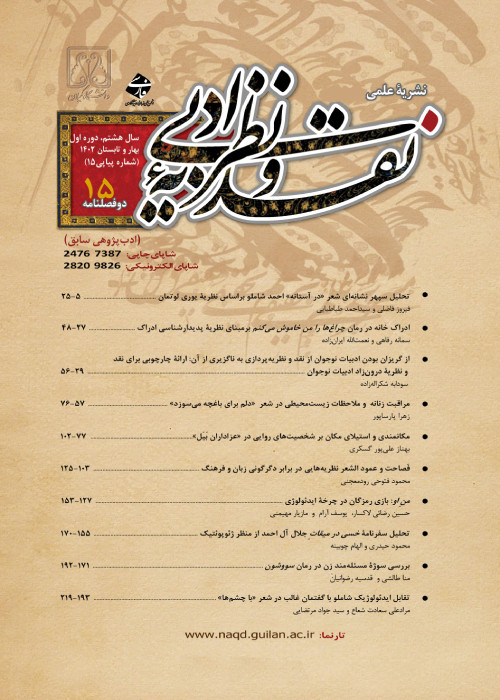A Study of the House Chronotope in Zoya Pirzad’s I Turn off the Lights
Author(s):
Article Type:
Research/Original Article (دارای رتبه معتبر)
Abstract:
The present article addresses the fundamental question of how the house chronotope, as a device for the analysis of text, opens up new interpretive possibilities. Basically referring to the continuum of time and space in literature and art, chronotope implies that time and space are not merely temporal and spatial categories but signify and have values attached to them. Following a descriptive-analytical method, the article has two sections: the first describes and defines the basic elements of the conceptual framework shaping Bakhtin’s discussion of chronotope, and the second examines Zoya Pirzad’s novel I Turn off the Lights in the light of the house chronotope. Moreover, the living room and kitchen chronotopes are examined in connection with the house chronotope (as the basic chronotope of the story). The article also shows that in the novel’s plot and interpretation, the house chronotope establishes a significant interaction with other important chronotopes, i.e., the threshold and encounter chronotopes. The article aims to demonstrate that the house chronotope reveals the characters’ mentalities and inner states by providing a proper space for the occurrence of events, and these events are expressed via temporal signs. Extended Abstract 1.IntroductionThe present article seeks to analyze the house chronotope in Zoya Pirzad’s I Turn off the Lights (Cheragh-ha ra Man Khamoush Mikonam) based on Bakhtin’s theory of literary chronotope. We will discuss how chronotope can serve as a tool for the analysis of the text, and will show the different ways in which it can be of help to the critic in analyzing a text. The house chronotope is of great importance in Pirzad’s novel, playing an important role in how the story develops. We have drawn upon Bakhtin’s definitions of different chronotopes and tried to identify their similarities in order study the house chronotope in this novel. 2.Theoretical Framework Chronotope is the interdependence among temporal and spatial relations, arranged through an artistic expression. In a literary or artistic work, different chronotopes and their complicated relationships can be identified. In this relationship, time and space do not exist independently and through specific instances of them, the experiences of characters can be defined in specific times and places. Therefore, it is through this relationship that a specific text offers a meaning to its creator or its readers. 3.MethodologyA qualitative study, the present article follows the descriptive-analytical methodology. Bakhtin’s theory of chronotope has been used here as a tool for the analysis of Pirzad’s I Turn off the Lights. The data was collected using the library sources. 4.Discussion and AnalysisThe house chronotope has been the basis for our analysis of Pirzad’s I Turn off the Lights. Throughout the story ‘house’ is referred to as a place that connotes various meanings, providing us with the possibility of analyzing different layers of the narrative in this novel. The everyday activities of the protagonist and her monologues occur within this chronotope, representing different aspects of her identity. Moreover, the relationship between this chronotope and other important chronotopes has been discussed in this article. 5.Conclusion In this novel, Pirzad strikes a balance between Clarice’s mental life and her inner life, thus making the arrangement of narration in the house chronotope possible. The representation of Clarice’s outer actions in this chronotope enables the reader to read into her mind. Pirzad creates the text based on her specific temporal and spatial conditions, while the readers recreate it based on their own spatial and temporal conditions. In other words, the chronotope turns into a tool for understanding the ways in which the spatial-temporal structures of the novel represent an independent world, the interpretation of which relies on the relationship between two worlds: the world of the text and the world of the meta-text. Select BibliographyPirzad, Z. 1380 [2001]. Cheragh-ha ra Man Khamoush Mikonam. Tehran: Markaz.Bakhtin, M. 1981. The Dialogic Imagination: Four Essays. Michael Holquist (ed.). Caryl Emerson and Micheal Holquist (trans.). Astin: University of Texas Press.Bakhtin, M. 1990. Art and Answerability: The Early Essays of M. M. Bakhtin. V. Liapunov and K. Brostrom (trans.).Texas: University of Texas Press.Bakhtin, M. 1993. Toward a Philosophy of the Act. V. Liapunov and M. Holquist (trans.). Texas: University of Texas Press.Bemong, N. and Borghart, P. (eds.). 2010. Bakhtin’s Theory of the Literary Chronotope: Reflections, Applications, Perspectives. Ghent: Academic Press. pp. 3-16.Heynes, D. J. 2002. “Bakhtin and the Visual Arts.” In: Smith, P. and C. Wilde (eds.). A Companion to Art Theory. Oxford: Blackwell Publishing. pp. 292-302.Holquist, M. 2002. Dialogism: Bakhtin and His World. London: Routledge.Keunen, B. 2000. “Bakhtin, Genre Formation, and the Cognitive Turn: Chronotopes as Memory Schemata.” CLCWeb: Comparative Literature and Culture 2/2: 1-15.Morson, G. S. and Emerson, C. 1990. Mikhail Bakhtin: Creation of a Prosaics. Standford: Standford University Press.
Keywords:
Language:
Persian
Published:
Literary Theory and Criticism, Volume:7 Issue: 1, 2022
Pages:
5 to 27
magiran.com/p2523244
دانلود و مطالعه متن این مقاله با یکی از روشهای زیر امکان پذیر است:
اشتراک شخصی
با عضویت و پرداخت آنلاین حق اشتراک یکساله به مبلغ 1,390,000ريال میتوانید 70 عنوان مطلب دانلود کنید!
اشتراک سازمانی
به کتابخانه دانشگاه یا محل کار خود پیشنهاد کنید تا اشتراک سازمانی این پایگاه را برای دسترسی نامحدود همه کاربران به متن مطالب تهیه نمایند!
توجه!
- حق عضویت دریافتی صرف حمایت از نشریات عضو و نگهداری، تکمیل و توسعه مگیران میشود.
- پرداخت حق اشتراک و دانلود مقالات اجازه بازنشر آن در سایر رسانههای چاپی و دیجیتال را به کاربر نمیدهد.
In order to view content subscription is required
Personal subscription
Subscribe magiran.com for 70 € euros via PayPal and download 70 articles during a year.
Organization subscription
Please contact us to subscribe your university or library for unlimited access!



